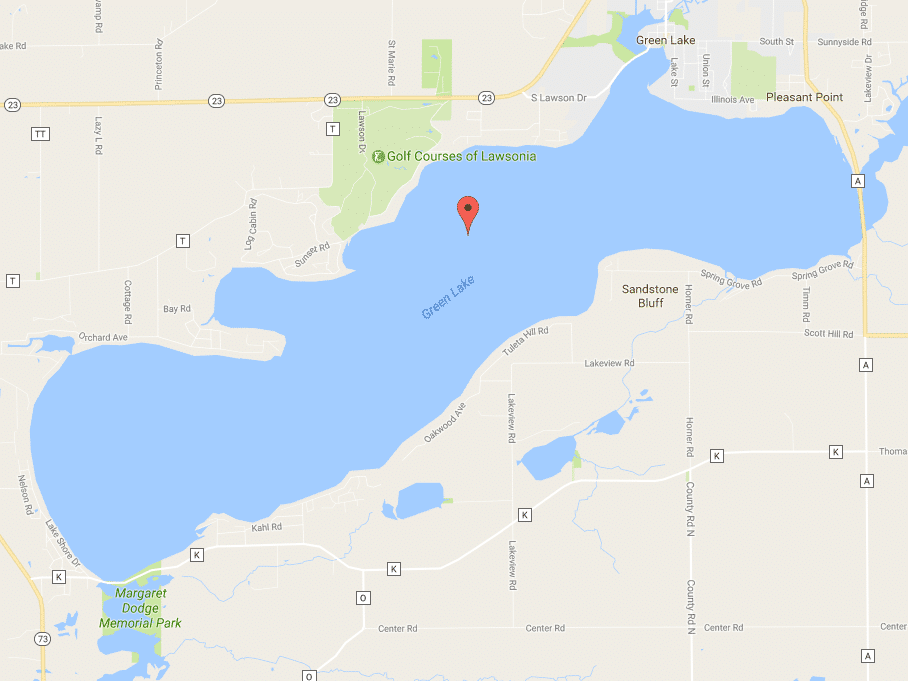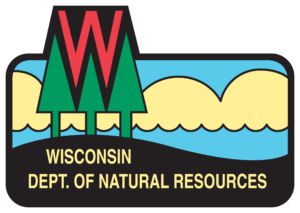
On Sunday, June 4th a friend and I set out to fish for bass on Big Green Lake in Wisconsin. My favorite lake. It’s the deepest inland lake in Wisconsin. Home to a wide variety of fish… and known for it’s crystal clear waters. The clear waters can make fishing a challenge… but also can make for some amazing sites, like seeing a pod of baitfish that is the size of a football field, or a school of fish swimming along a ledge, or being able to see the bottom in 15’+ of water.
We pulled up to the ramp… and were treated to the worse water conditions I’ve ever seen on Big Green. It prompted this post in the Fishnetics Facebook group:
I was not a happy camper and emailed the DNR to find out what the heck is going on.
What the DNR had to say about Big Green Lake
Yesterday Chad Johnson from the DNR (based out of Oshkosh) called me to discuss. I was very informative… and restored my confidence in the lake. Here are the highlights of our conversation:
About Big Green Lake and the Herbicide Treatments
The County/City of Green Lake have invested about 3.3 million dollars to improve the water quality of Big Green Lake which includes (but not limited to)
- Improving the watershed
- Better waste water treatment
- Preventing run-off
- Improving the marsh south of HWY K, which feeds into Big Green
- Treating the lake with herbicide to deal with the invasive Curly Leaf Pond Weed
- The water quality of Big Green Lake is actually the best it’s been in years. The water quality was terrible and plummiting in the 80’s… and got worse in the 90’s. The investment above and hard work by the DNR and people who use the lake have resulting in turning that trend around and the water quality is improving every year.
- The treatment of the Curly Leaf Pond Weed is what they have been spraying the lake for the last few years.
- The Curly Leaf Pond Weed is what was choking out Beyer’s Cove and the Mill Pond.
- Curly Leaf Pond Weed (read this article to know more) is a major problem and they had to treat it now before the problem became significantly worse
- The herbicide treatment to eliminate the weed is a five year process. They plants grow from very thick bases, and a single years treatment isn’t enough to kill them off. It takes 5 years of consecutive treatments. Big Green is in year 3 (or year 4) of a 5 year plan. .
- Curly Leaf Pond Weed, unlike native weeds formed dense mats in late spring and into early summer. However, by mid summer they die off… unlike native plants that die off in the fall
- This early die off would result in cause rafts of dying curlyleaf to pile up on shore, increase phosphorus concentrations in the lake which in turn lead to an increase in algae during the mid summer months
-
A filamentous algae bloom
The current filamentous algae bloom is partially due to the herbicide treatment in early May wish resulted in the dead plants increasing phosphorus concentrations in the lake, which the algae are feeding on. There are other factors:
- The lake has gotten run-off via the marsh south of HWY K, especially with the resent rains and storms.
- The marsh is being addressed with a HUGH native project to re-introduce native plants into the marsh, which will help with the run-off
- The zebra mussels are also to blame. They are the other invasive species that is changing the dynamics of the lake.
- Where there are zebra mussels, there is usually filamentous algae blooms.
- The lake has gotten run-off via the marsh south of HWY K, especially with the resent rains and storms.
*After our conversation was over I thought about that statement of the zebra mussels & filamentous algae blooms…. I don’t recall large outbreaks of filamentous algae blooms on any body of water… until zebra mussels started showing up. Can anyone else confirm this observation?
About the Fish in Big Green Lake
Chad is an avid scuba diver and loves to dive on Big Green. He was able to share some first hand observations:
- He assured me that the bass and other bedding fish are able to deal with the filamentous algae booms. They are still able to establish beds and just work harder at keeping them clean.
- Due to the (normally) clear nature of the water, many of the fish just spawn deeper. He has personally seen bass and bluegill beds down around 20′ deep. (He told me some exact locations… but those I’m keeping for myself to checkout my next trip on the water)
- The marsh south of HWY K and the marsh to the east of HWY A have not been treated with herbicide and are popular spawning areas for the fish as well.
- The lake has amazing and healthy populations of all species of fish that it has. We talked for a long time about the schools of panfish, bass, baitfish, lake trout, and more. (However, I’m not sharing specifics. He gave some great details about where he see’s them, the size of the fish, and more. I’m going to use that info to catch more fish. Go find your own hot tips!)
- The lake has freshwater shrimp…. AKA Scuds. (You know… the same thing that the perch in the Dakotas eat and grow to massive sizes on). He’s caught lake trout and walleye that were stuffed with them. Gives their meat a pink color and a sweater taste. If you are cruising over deep water and detect a large baitfish school… it might actually be a cloud of freshwater shrimp!
Long Story, Short
When I fired off an email to the DNR, I wasn’t sure I’d hear back. I’m really pleased that Chad not only called me and talked to me at length. It was a great phone call. I’m feeling much more positive about the Big Green Lake and it’s future. I think it’s in good hands. The next few years may still be rough as they finish the treatments for the Curly Leaf Pond Weed and the march south of HWY K. But the lake should be in amazing shape in the early 2020’s and beyond.
- Vincent Wondra


 The County/City of Green Lake have invested about 3.3 million dollars to improve the water quality of Big Green Lake which includes (but not limited to)
The County/City of Green Lake have invested about 3.3 million dollars to improve the water quality of Big Green Lake which includes (but not limited to)
